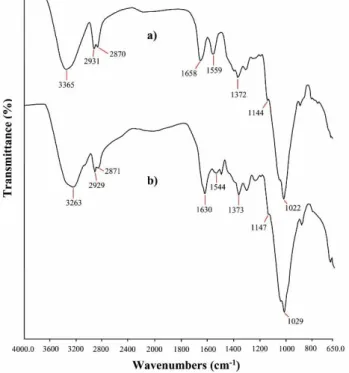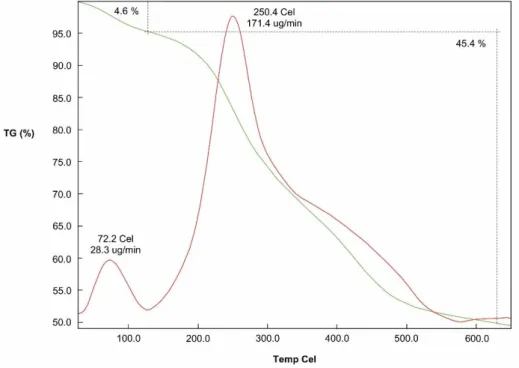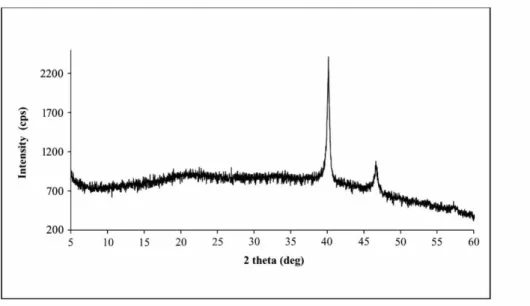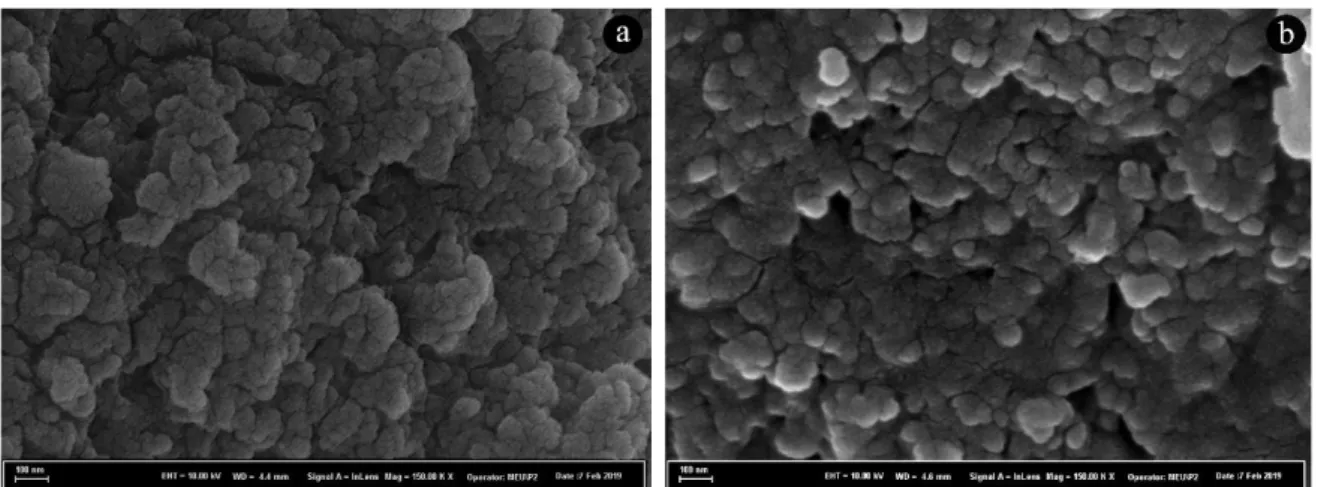HIGHLY ACTIVE AND ROBUST PALLADIUM NANOPARTICLES IMMOBILIZED ON BIODEGRADABLE MICROCAPSULES CONTAINING CHITOSAN-GUAR GUM COMPOSITE
FOR SYNTHESIS OF BIARYL COMPOUNDS
1Talat BARAN
1Aksaray University, Faculty of Science and Letters,Department of Chemistry, 68100 Aksaray, TURKEY 1talatbaran@aksaray.edu.tr
(Geliş/Received: 26.03.2019; Kabul/Accepted in Revised Form: 03.07.2019)
ABSTRACT: In this study, highly stable biodegradable microcapsules, which are composed of chitosan-guar gum composite (CS-GG), were prepared as catalyst support. Then, palladium nanoparticles were successfully decorated on the designed support without using any toxic reducing agent (Pd NPs@CS-GG). Structural characterizations of CS-GG and Pd NPs@CS-GG were carried out by different analytical techniques and it was detected that the size of palladium nanoparticles changed in the range of 23-48 nm. Then, the catalytic activity of Pd NPs@CS-GG was evaluated in the fabrication of various biaryl compounds under solventless media using microwave heating. Pd NPs@CS-GG showed high catalytic performance in the conversion of various aryl halides to desired biaryl compounds with good reaction yields. Moreover, it was found that Pd NPs@CS-GG was a catalyst having long life time because of its reuse at least seven times.
Key Words: Chitosan, Microcapsule, Catalyst, Palladium Nanoparticle
Biaril Bileşiklerinin Sentezi İçin Kitosan-Guar Sakizi Kompoziti İçeren Biyobozunur Mikrokapsüller Üzerine İmmobilize Edilmiş Oldukça Aktif ve Sağlam Paladyum Nanopartiküller ÖZ: Bu çalışmada, kitosan-guar sakızı kompozitinden (CS-GG) oluşan son derece kararlı biyobozunur mikro kapsüller, katalizör desteği olarak hazırlandı. Daha sonra, paladyum partikülleri, herhangi bir toksik indirgeyici madde kullanmadan tasarlanan destek üzerine başarıyla dekore edildi (Pd NP@CS-GG). CS-GG ve Pd NP@CS-GG’lerin yapısal karakterizasyonu farklı analitik tekniklerle yapıldı ve paladyum nanopartiküllerinin boyutunun 23-48 nm aralığında değiştiği tespit edildi. Daha sonra, Pd NP @ CS-GG'nin katalitik aktivitesi, mikrodalga ısıtma kullanılarak çözücüsüz ortam altında çeşitli biaril bileşiklerin üretiminde değerlendirildi. Pd NPs@CS-GG, çeşitli aril halojenürlerin iyi reaksiyon verimleriyle istenilen biaril bileşiklerine dönüştürülmesinde yüksek katalitik performans gösterdi. Ayrıca, Pd NPs@CS-GG'nin, en az yedi kez tekrar kullanımı nedeniyle uzun yaşam süresine sahip bir katalizör olduğu bulundu.
Anahtar Kelimeler: Kitosan, Mikro Kapsül, Katalizör, Paladyum Nanopartikül
INTRODUCTION
Noble metal nanoparticles have recently attracted much attention due to their interesting chemical structure and electronic, mechanical, optical, and magnetic properties. Therefore, they have been widely used in different application areas such as photonics, electronics, biology and medicine (Daniel and
Astruc, 2004; Nasrollahzadeh et al., 2015; Rai et al., 2009). On the other hand, one of the most significant promising application area of metal nanoparticles is the use as catalyst in catalytic reactions (Gholinejad et al., 2017; Sudhakar and Soni, 2018). For these reasons, researchers have prepared different types of noble nanoparticles such as Cu, Ag, Au and Pt to use in catalytic applications (Naghdi et al., 2018; Nasrollahzadeh et al., 2015; Nasrollahzadeh et al., 2018; Rathi et al., 2016). Among noble metal nanoparticles, palladium nanoparticles are the most widely used as catalyst in the catalytic reactions due to their unique properties such as good thermal stability, high chemical stability and photo catalytic activity (Chen and Ostrom, 2015; Phan et al., 2019). On the other hand, one of the most important problem in the synthesis of nanoparticles is aggregation and it can be negatively affect catalytic activity of catalyst (Cui et al., 2017). The best way to overcome this problem is immobilization of nanoparticles on suitable solid supports (Nasrollahzadeh et al., 2019). Additionally, shape, size and stability of nanoparticles depend on support. Therefore, there is need ideal support for immobilization of nanoparticles. In recent years, researchers have used different inorganic materials such as zeolite (Xue et al., 2016), TiO2 (Atarod et al., 2016), graphene oxide (Zahed and Hosseini-Monfared, 2015), perlit
(Nasrollahzadeh et al., 2015), Fe3O4 (Veisi et al. 2015), and carbon nanotube (Xiang et al., 2003) as support
for fabrication of metallic nanoparticles.
Natural biopolymers are important materials due to their low cost, large surface area, renewability, biocompatibility, high thermal stability, and environmentally friendly properties (Baran, 2017; Rajender Reddy et al., 2006). These outstanding properties make biopolymers or their composites an important candidate as stabilizer for immobilization of metallic nanoparticles. Chitosan and guar gum are the most important members of the polysaccharide family. Chitosan is a cationic carbohydrate polymer which is derived by deacetylation of chitin obtained from waste products of sea such as shrimp, crab, krill, and crayfish (Baskar and Kumar, 2009; Tajik et al., 2008). Guar gum is a biopolymer with high molecular weight that is commonly extracted from the seed of the leguminous shrub Cyamopsis tetragonoloba (Mudgil et al., 2014; Pal et al., 2011). Additionally, chitosan and guar gum versatile materials are very economical, easily available and abundant in nature (Thombare et al., 2016; Wan Ngah et al., 2011). Both chitosan and guar gum have also free active functional groups such as –NH2 and
OH, which can be strongly interacted with metal ions, on the polymer backbone (Sharma et al., 2018; Zhang et al., 2016). These significant characteristics make chitosan and guar gum a desirable support material for catalytic reactions.
In this study, a novel highly thermally durable support material (CS-GG), which was composed from chitosan-guar gum microspheres, was designed and then palladium nanoparticles were successfully decorated on the prepared CS-GG. Chemical structures of the fabricated CS-GG and Pd NPs@CS-GG were illuminated by different analytical techniques. Then, catalytic behavior of Pd NPs@CS-GG was evaluated in the synthesis of a series of biaryl compounds. These tests revealed that Pd NPs@CS-GG catalyzed fabrication of biaryl compounds with good reaction yields in the solvent-free media. Furthermore, it was found that Pd NPs@CS-GG was easily recovered from the reaction media and it could be reused at least for seven successive runs.
EXPERIMENTAL
Synthesis of support material (CS-GG)
1 g of chitosan was dissolved in 2% acetic acid solution (v:v) and then 1 g of guar gum was added in the reaction mixture and it was stirred at room temperature for overnight. Resulting chitosan-guar gum mixture was dropped into solution of water:methanol:NaOH (40mL:60mL:12g) to obtain gelatinous microspheres. Subsequently, gelatinous chitosan-guar gum microspheres were extensively washed with water to neutrality. Finally, microspheres were transferred into the solution of glutaraldehyde (5 mL) in methanol (50 mL) and the mixture was stirred under reflux for 24 h for linking. After the cross-linking procedure, chitosan-guar gum microspheres were filtered, washed with methanol and dried.
Preparation of palladium nanoparticles on CS-GG
0. 5 g of CS-GG was added to the solution of PdCl2 (0.2 g, 20 mL) in ethanol and the reaction mixture
was stirred at 70°C for 4 h to provide completely reduction of Pd(+2) to Pd(0). It was observed that the color of the reaction solution also changed to dark gray after this period. Finally, palladium nanoparticles were collected by filtration, rinsed with water and dried.
Typical procedure for synthesis of biaryl compounds in the presence of Pd NPs@CS-GG
The mixture of aryl halides (1.0 mmol), phenylboronic acid (1.8 mmol), K2CO3 (3.5 mmol) and Pd
NPs@CS-GG (3x10-2 mmol) were placed in a Schlenk tube and then it was irradiated by microwave for 6
min. After the completion of the coupling reaction, 10 mL of water was added reaction mixture and then the resulting mixture was extracted with toluene. Subsequently, organic phase was dried over anhydrous MgSO4, and the solvent was evaporated to obtain biaryl compounds. Finally,
characterizations of biaryls were performed by GC/MS. RESULTS AND DISCUSSION
Characterization of Pd NPs@CS-GG
Chemical structures of CS-GG microcapsules and Pd NPs@CS-GG were investigated by FT-IR analysis and their spectra are illustrated in Fig. 1. FTIR spectrum of CS-GG microcapsules displayed characteristic bands at 3365cm-1 (stretching of N-H and OH), 2931 and 2870cm-1 (stretching of C-H),
1559cm-1 (amide II band of chitosan), 1372cm-1 (stretching of NHCOCH3 group), 1444 and 1022cm-1
(stretching of C–O–C and C-C) (Baran et al., 2015; Seeli and Prabaharan, 2017). Additionally, a strongly band was observed at 1658cm-1 which was attributed to imine vibrations. These results showed the
formation of chitosan-guar microcapsules. On the other hand, it was observed that these characteristic bands shifted to lower or higher wavenumbers in the spectrum of Pd NPs@CS-GG. These important changes can be attributed to strongly interaction of CS-GG microcapsules with palladium nanoparticles.
Surface characteristics of CS-GG microcapsules and Pd NPs@CS-GG were studied by FE-SEM. As clearly shown in Fig. 2, GG microcapsules and Pd NPs@GG had spherical formation. While CS-GG microcapsules had nearly smooth surface (Fig. 2a), the surface of Pd NPs@CS-CS-GG was covered with particles after the fabrication of palladium nanoparticles (Fig. 2b). Additionally, the surface morphology of Pd NPs@CS-GG was investigated at higher magnification to confirm the formation of nanoparticles (Fig. 2c). As seen in FE-SEM microgram of Pd NPs@CS-GG, palladium nanoparticles were successfully fabricated on the support and their average diameters were found to be between 23 and 48 nm.
Figure 2. FE-SEM images of a) CS-GG microcapsules and b) Pd NPs@CS-GG
Thermal durability of catalysts is one of the most important properties in catalytic systems to retain their catalytic performance. TG/DTG analysis was employed to determine thermal stability of Pd NPs@CS-GG and its curve is given in Fig. 3. When TG/DTG spectrum of Pd NPs@CS-GG was examined, it was found that Pd NPs@CS-GG had high thermal stability by protecting its chemical structure up to 250.4°C (Tmax). This results show that Pd NPs@CS-GG is a suitable catalyst for catalytic systems which
require high reaction temperature.
Figure 3. TG/DTG spectrum of Pd NPs@CS-GG
XRD analysis was performed to illuminate the crystalline nature of Pd NPs@CS-GG and its pattern is given in Fig 4. When XRD diagram of Pd NPs@CS-GG was examined, a weak and broad peak at 21.64° was observed which corresponded to characteristic peaks of chitosan and guar gum (Baran et al., 2015; Seeli and Prabaharan, 2016). Pd NPs@CS-GG also exhibited strong two peaks at 40.18° and 46.68° which corresponded to (111) and (200) crystalline planes of Pd, respectively (Nasrollahzadeh and Sajadi, 2016). These results showed the presence of palladium nanoparticles on the CS-GG.
Figure 4. XRD pattern of Pd NPs@CS-GG
Microwave-assisted synthesis of biaryl compounds in the presence of Pd NPs@CS-GG
Synthesis of biaryl compounds were carried out using microwave heating because it offers (i) higher reaction yields with short reaction time and, (ii) easy and safe operation when compared to traditional heating methods. Additionally, in terms of green chemistry, no solvent was used in the catalytic reactions. Before catalytic tests of Pd NPs@CS-GG, determination of reaction conditions such as base type, reaction time and amount of catalyst require because they affect reaction yield. To optimize the reaction conditions, 4-iodide anisole and phenylboronic acid were chosen as model substrates and then preliminary studies were carried out. The best reaction yield was reached with K2CO3 as base system, for
6 min reaction time and using 3x10-2 mmol amount of catalyst. Then, catalytic performance of Pd
NPs@CS-GG was investigated against various Suzuki cross coupling reactions under the determined optimum conditions (Table 1). As seen in Table 1, catalytic activity of Pd NPs@CS-GG was studied in Suzuki cross coupling reactions of a range of aryl halides with phenylboronic acid. Firstly, coupling reactions of different substituted aryl iodides were performed in the presence of Pd NPs@CS-GG and the desired biaryl compounds were obtained with good reactions yields (Table 1, entries 1-4). For example, meta-NO2 substituted aryl iodide afforded 94% yield (entry 2). At the next step, Pd NPs@CS-GG was
also tested in the coupling reactions of a variety of aryl bromides and it was found that the yields of synthesized biaryl compounds were in the range from 70% to 98% (Table 1, entries 5-9). For example, the reaction of 4-bromobenzonitrile with phenylboronic acid produced the desired biaryl product with 98% yield. Finally, the substrates versatility of Pd NPs@CS-GG was also tested against aryl chlorides which are less reactive compared to aryl iodides and bromides in the coupling reactions (Table 1, entries 10-13). Pd NPs@CS-GG successfully catalyzed the conversion of aryl chloride to desired biaryl products. 76% and 82% reaction yields were reached for meta substituted–NO2 and para substituted–CN aryl chlorides,
respectively (Table 1, entries 11 and 12). The performed catalytic tests indicate that Pd NPs@CS-GG is a suitable catalyst for synthesis of biaryl compounds.
Table 1. Catalytic behavior of Pd NPs@CS-GG against synthesis of biaryls
Reaction conditions: 1.8 mmol aryl halides, 1.2 mmol phenyl boronic acid, 3.5 mmol K2CO3, 3x10-2
mmol Pd NPs@CS-GG, 6 min, 400 W.
Reusability of Pd NPs@CS-GG
Highly reusable catalysts are desired for academic researches and industrial applications due to their economical and practical advantages (Baran et al., 2018). Therefore, in this study, reusability of Pd NPs@CS-GG was checked on the model reaction. After first cycle, Pd NPs@CS-GG was easily recovered with filtration from reaction media and it was rinsed with hot water, dried and then directly used for next runs. This process was repeated for each cycle. Reusability tests revealed that Pd NPs@CS-GG could be successfully reused seven times by giving 72% yield. This result shows that Pd NPs@CS-GG is a highly retrievable and reusable catalyst. FE-SEM analysis of the catalyst was performed after seven consecutive runs and it showed that the chemical structure of the catalyst was retained (Fig.5). Additionally, possible reaction mechanism of Suzuki coupling reaction using Pd NPs@CS-GG is given in Figure 6. Entry X R Yield 1 I 4-OCH3 98 2 I 3-NO2 94 3 I 4-NH2 80 4 I 4-CH3 78 5 Br 4-OCH3 92 6 Br 4-NH2 77 7 Br 3-NO2 92 8 Br 4-CN 98 9 Br 4-CH3 70 10 Cl 4-OCH3 69 11 Cl 3-NO2 76 12 Cl 4-CN 82 13 Cl 4-CH3 48
Figure 5. Surface morphologies of Pd NPs@CS-GG after a) 1th and b) 7th cycle
Figure 6. Possible mechanism of Suzuki coupling reaction using Pd NPs@CS-GG.
CONCLUSIONS
In conclusion, Pd NPs@CS-GG was successfully designed, characterized and then it was used as heterogeneous catalyst for construction of several biaryl compounds. Catalytic studies showed that Pd NPs@CS-GG was a highly active catalyst which converted aryl iodides and bromides having variety of functionalized substrates to desired biaryl compounds with excellent yields. Pd NPs@CS-GG also served as a good catalyst for aryl chlorides. Furthermore, the prepared Pd NPs@CS-GG presented good recoverability and recyclability for at least seven runs. These findings indicate that Pd NPs@CS-GG is a useful catalyst for Suzuki cross coupling reactions.
REFERENCES
Atarod, M., Nasrollahzadeh, M., Sajadi, S. M., 2016, "Euphorbia heterophylla leaf extract mediated green synthesis of Ag/TiO2 nanocomposite and investigation of its excellent catalytic activity for reduction of variety of dyes in water", Journal of Colloid and Interface Science, 462, 272-279.
Baran, T., 2017, "Practical, economical, and eco-friendly starch-supported palladium catalyst for Suzuki coupling reactions" Journal of colloid and interface science, 496, 446-455.
Baran, T., Menteş, A., Arslan, H., 2015, "Synthesis and characterization of water soluble O-carboxymethyl chitosan Schiff bases and Cu(II) complexes", International Journal of Biological Macromolecules, 72, 94-103.
Baran, T., Sargın, İ., Kaya, M., Mulerčikas, P., Kazlauskaitė, S., Menteş, A., 2018, "Production of magnetically recoverable, thermally stable, bio-based catalyst: Remarkable turnover frequency and reusability in Suzuki coupling reaction", Chemical Engineering Journal, 331, 102-113.
Baskar, D., Kumar, T. S., 2009, "Effect of deacetylation time on the preparation, properties and swelling behavior of chitosan films", Carbohydrate Polymers, 78(4), 767-772.
Chen, A., Ostrom, C., 2015, "Palladium-based nanomaterials: synthesis and electrochemical applications", Chemical Reviews, 115(21), 11999-12044.
Cui, X., Li, H., Yuan, M., Yang, J., Xu, D., Li, Z., Dong, Z., 2017, "Facile preparation of fluffy N-doped carbon modified with Ag nanoparticles as a highly active and reusable catalyst for catalytic reduction of nitroarenes", Journal of Colloid and Interface Science, 506, 524-531.
Daniel, M.-C., Astruc, D., 2004, "Gold nanoparticles: assembly, supramolecular chemistry, quantum-size-related properties, and applications toward biology, catalysis, and nanotechnology", Chemical Reviews, 104(1), 293-346.
Gholinejad, M., Najera, C., Hamed, F., Seyedhamzeh, M., Bahrami, M., Kompany-Zareh, M., 2017, "Green synthesis of carbon quantum dots from vanillin for modification of magnetite nanoparticles and formation of palladium nanoparticles: Efficient catalyst for Suzuki reaction" Tetrahedron, 73(38), 5585-5592.
Mudgil, D., Barak, S., Khatkar, B. S., 2014, "Guar gum: processing, properties and food applications—A Review", Journal of Food Science and Technology, 51(3), 409-418.
Naghdi, S., Sajjadi, M., Nasrollahzadeh, M., Rhee, K. Y., Sajadi, S. M., Jaleh, B., 2018, "Cuscuta reflexa leaf extract mediated green synthesis of the Cu nanoparticles on graphene oxide/manganese dioxide nanocomposite and its catalytic activity toward reduction of nitroarenes and organic dyes", Journal of the Taiwan Institute of Chemical Engineers, 86, 158-173.
Nasrollahzadeh, M., Azarian, A., Maham, M., Ehsani, A., 2015, "Synthesis of Au/Pd bimetallic nanoparticles and their application in the Suzuki coupling reaction", Journal of Industrial and Engineering Chemistry, 21, 746-748.
Nasrollahzadeh, M., Issaabadi, Z., Sajadi, S. M., 2019, "Green synthesis of Cu/Al2O3 nanoparticles as efficient and recyclable catalyst for reduction of 2,4-dinitrophenylhydrazine, Methylene blue and Congo red", Composites Part B: Engineering, 166, 112-119.
Nasrollahzadeh, M., Mehdipour, E., Maryami, M., 2018, "Efficient catalytic reduction of nitroarenes and organic dyes in water by synthesized Ag/diatomite nanocomposite using Alocasia macrorrhiza leaf extract", Journal of Materials Science: Materials in Electronics, 29(19), 17054-17066.
Nasrollahzadeh, M., Sajadi, S. M., 2016, "Preparation of Pd/Fe3O4 nanoparticles by use of Euphorbia stracheyi Boiss root extract: A magnetically recoverable catalyst for one-pot reductive amination of aldehydes at room temperature", Journal of Colloid and Interface Science, 464, 147-152.
Nasrollahzadeh, M., Sajadi, S. M., Rostami-Vartooni, A., Bagherzadeh, M., 2015, "Green synthesis of Pd/CuO nanoparticles by Theobroma cacao L. seeds extract and their catalytic performance for the reduction of 4-nitrophenol and phosphine-free Heck coupling reaction under aerobic conditions", Journal of Colloid and Interface Science, 448, 106-113.
Nasrollahzadeh, M., Sajadi, S. M., Rostami-Vartooni, A., Bagherzadeh, M., Safari, R., 2015, "Immobilization of copper nanoparticles on perlite: Green synthesis, characterization and catalytic activity on aqueous reduction of 4-nitrophenol", Journal of Molecular Catalysis A: Chemical, 400, 22-30.
Pal, S., Ghorai, S., Dash, M. K., Ghosh, S., Udayabhanu, G., 2011, "Flocculation properties of polyacrylamide grafted carboxymethyl guar gum (CMG-g-PAM) synthesised by conventional and microwave assisted method", Journal of Hazardous materials, 192(3), 1580-1588.
Phan, T. T. V., Hoang, G., Nguyen, V. T., Nguyen, T. P., Kim, H. H., Mondal, S., Junghwan, O., 2019, "Chitosan as a stabilizer and size-control agent for synthesis of porous flower-shaped palladium nanoparticles and their applications on photo-based therapies", Carbohydrate Polymers, 205, 340-352.
Rai, M., Yadav, A., Gade, A., 2009, "Silver nanoparticles as a new generation of antimicrobials", Biotechnology advances, 27(1), 76-83.
Rajender Reddy, K., Kumar, N. S., Surendra Reddy, P., Sreedhar, B., Lakshmi Kantam, M., 2006, "Cellulose supported palladium(0) catalyst for Heck and Sonogashira coupling reactions", Journal of Molecular Catalysis A: Chemical, 252(1), 12-16.
Rathi, A. K., Gawande, M. B., Pechousek, J., Tucek, J., Aparicio, C., Petr, M., Varma, R. S., 2016, "Maghemite decorated with ultra-small palladium nanoparticles (γ-Fe 2 O 3–Pd): applications in the Heck–Mizoroki olefination, Suzuki reaction and allylic oxidation of alkenes", Green Chemistry, 18(8), 2363-2373.
Seeli, D. S., Prabaharan, M., 2016, "Guar gum succinate as a carrier for colon-specific drug delivery", International Journal of Biological Macromolecules, 84, 10-15.
Seeli, D. S., Prabaharan, M., 2017, "Guar gum oleate-graft-poly(methacrylic acid) hydrogel as a colon-specific controlled drug delivery carrier", Carbohydrate Polymers, 158, 51-57.
Sharma, G., Sharma, S., Kumar, A., Al-Muhtaseb, A. A. H., Naushad, M., Ghfar, A. A., Stadler, F. J., 2018, "Guar gum and its composites as potential materials for diverse applications: A review", Carbohydrate Polymers, 199, 534-545.
Sudhakar, P., Soni, H., 2018, "Catalytic reduction of Nitrophenols using silver nanoparticles-supported activated carbon derived from agro-waste", Journal of environmental chemical engineering, 6(1), 28-36.
Tajik, H., Moradi, M., Rohani, S., Erfani, A., Jalali, F., 2008, "Preparation of chitosan from brine shrimp (Artemia urmiana) cyst shells and effects of different chemical processing sequences on the physicochemical and functional properties of the product", Molecules, 13(6), 1263-1274.
Thombare, N., Jha, U., Mishra, S., Siddiqui, M. Z., 2016, "Guar gum as a promising starting material for diverse applications: A review", International Journal of Biological Macromolecules, 88, 361-372.
Veisi, H., Gholami, J., Ueda, H., Mohammadi, P., Noroozi, M., 2015, "Magnetically palladium catalyst stabilized by diaminoglyoxime-functionalized magnetic Fe3O4 nanoparticles as active and reusable catalyst for Suzuki coupling reactions", Journal of Molecular Catalysis A: Chemical, 396, 216-223.
Wan Ngah, W. S., Teong, L. C., Hanafiah, M. A. K. M., 2011, "Adsorption of dyes and heavy metal ions by chitosan composites: A review", Carbohydrate Polymers, 83(4), 1446-1456.
Xiang, R. Y., Lin, Y., Wai, C. M., 2003, "Decorating catalytic palladium nanoparticles on carbon nanotubes in supercritical carbon dioxide", Chemical Communications(5), 642-643.
Xue, S., Jiang, H., Zhong, Z., Low, Z.-X., Chen, R., Xing, W., 2016, "Palladium nanoparticles supported on a two-dimensional layered zeolitic imidazolate framework-L as an efficient size-selective catalyst", Microporous and Mesoporous Materials, 221, 220-227.
Zahed, B., Hosseini-Monfared, H., 2015, "A comparative study of silver-graphene oxide nanocomposites as a recyclable catalyst for the aerobic oxidation of benzyl alcohol: Support effect", Applied Surface Science, 328, 536-547.
Zhang, L., Zeng, Y., Cheng, Z., 2016, "Removal of heavy metal ions using chitosan and modified chitosan: A review", Journal of Molecular Liquids, 214, 175-191.




